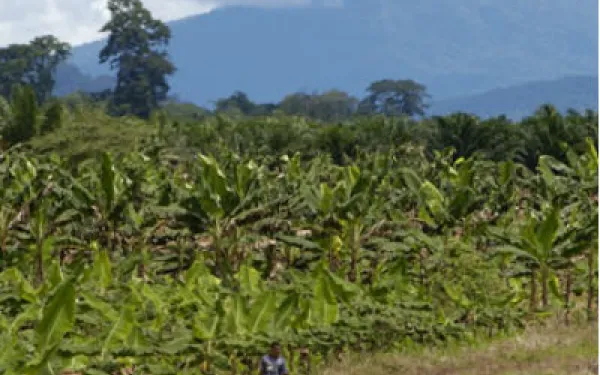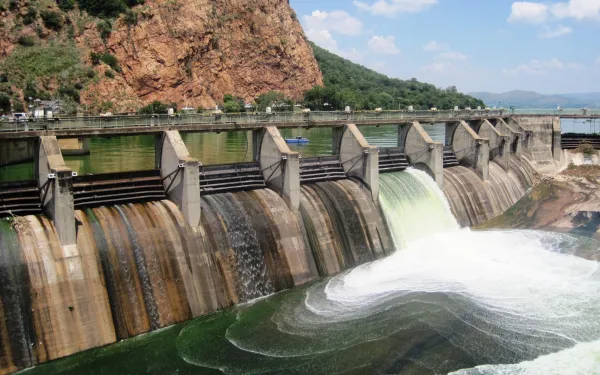
Project
Protecting the health of La Oroya's residents from toxic pollution
For more than 20 years, residents of La Oroya have been seeking justice and reparations after a metallurgical complex caused heavy metal pollution in their community—in violation of their fundamental rights—and the government failed to take adequate measures to protect them.
On March 22, 2024, the Inter-American Court of Human Rights issued its judgment in the case. It found Peru responsible and ordered it to adopt comprehensive reparation measures. This decision is a historic opportunity to restore the rights of the victims, as well as an important precedent for the protection of the right to a healthy environment in Latin America and for adequate state oversight of corporate activities.
Background
La Oroya is a small city in Peru’s central mountain range, in the department of Junín, about 176 km from Lima. It has a population of around 30,000 inhabitants.
There, in 1922, the U.S. company Cerro de Pasco Cooper Corporation installed the La Oroya Metallurgical Complex to process ore concentrates with high levels of lead, copper, zinc, silver and gold, as well as other contaminants such as sulfur, cadmium and arsenic.
The complex was nationalized in 1974 and operated by the State until 1997, when it was acquired by the US Doe Run Company through its subsidiary Doe Run Peru. In 2009, due to the company's financial crisis, the complex's operations were suspended.
Decades of damage to public health
The Peruvian State - due to the lack of adequate control systems, constant supervision, imposition of sanctions and adoption of immediate actions - has allowed the metallurgical complex to generate very high levels of contamination for decades that have seriously affected the health of residents of La Oroya for generations.
Those living in La Oroya have a higher risk or propensity to develop cancer due to historical exposure to heavy metals. While the health effects of toxic contamination are not immediately noticeable, they may be irreversible or become evident over the long term, affecting the population at various levels. Moreover, the impacts have been differentiated —and even more severe— among children, women and the elderly.
Most of the affected people presented lead levels higher than those recommended by the World Health Organization and, in some cases, higher levels of arsenic and cadmium; in addition to stress, anxiety, skin disorders, gastric problems, chronic headaches and respiratory or cardiac problems, among others.
The search for justice
Over time, several actions were brought at the national and international levels to obtain oversight of the metallurgical complex and its impacts, as well as to obtain redress for the violation of the rights of affected people.
AIDA became involved with La Oroya in 1997 and, since then, we’ve employed various strategies to protect public health, the environment and the rights of its inhabitants.
In 2002, our publication La Oroya Cannot Wait helped to make La Oroya's situation visible internationally and demand remedial measures.
That same year, a group of residents of La Oroya filed an enforcement action against the Ministry of Health and the General Directorate of Environmental Health to protect their rights and those of the rest of the population.
In 2006, they obtained a partially favorable decision from the Constitutional Court that ordered protective measures. However, after more than 14 years, no measures were taken to implement the ruling and the highest court did not take action to enforce it.
Given the lack of effective responses at the national level, AIDA —together with an international coalition of organizations— took the case to the Inter-American Commission on Human Rights (IACHR) and in November 2005 requested measures to protect the right to life, personal integrity and health of the people affected. In 2006, we filed a complaint with the IACHR against the Peruvian State for the violation of the human rights of La Oroya residents.
In 2007, in response to the petition, the IACHR granted protection measures to 65 people from La Oroya and in 2016 extended them to another 15.
Current Situation
To date, the protection measures granted by the IACHR are still in effect. Although the State has issued some decisions to somewhat control the company and the levels of contamination in the area, these have not been effective in protecting the rights of the population or in urgently implementing the necessary actions in La Oroya.
Although the levels of lead and other heavy metals in the blood have decreased since the suspension of operations at the complex, this does not imply that the effects of the contamination have disappeared because the metals remain in other parts of the body and their impacts can appear over the years. The State has not carried out a comprehensive diagnosis and follow-up of the people who were highly exposed to heavy metals at La Oroya. There is also a lack of an epidemiological and blood study on children to show the current state of contamination of the population and its comparison with the studies carried out between 1999 and 2005.
The case before the Inter-American Court
As for the international complaint, in October 2021 —15 years after the process began— the IACHR adopted a decision on the merits of the case and submitted it to the Inter-American Court of Human Rights, after establishing the international responsibility of the Peruvian State in the violation of human rights of residents of La Oroya.
The Court heard the case at a public hearing in October 2022. More than a year later, on March 22, 2024, the international court issued its judgment. In its ruling, the first of its kind, it held Peru responsible for violating the rights of the residents of La Oroya and ordered the government to adopt comprehensive reparation measures, including environmental remediation, reduction and mitigation of polluting emissions, air quality monitoring, free and specialized medical care, compensation, and a resettlement plan for the affected people.
Partners:

Related projects

Environmental Impact Assessments Necessary for Informed Consent
In January 2009, Muriel Mining Corporation moved into the department of Chocó, Colombia to launch Mandé Norte, a project for the exploration and development of copper, gold, molybdenum and other minerals. The US-based company began the project without proper consultation, and without the free, prior and informed consent of the local ethnic groups that would be directly affected by the mines. Consultation with the affected communities did not begin until 2006, a year after the company was awarded the mining contract. What's more, several of the affected communities were not invited to participate in the consultation process, and those that participated were not represented by traditional authorities. Then, despite serious objections raised by Afro-Colombian and indigenous communities, the consultation process was concluded in August 2008. This project took place during a difficult period of Colombia’s armed conflict.The Inter-Church Commission for Justice and Peace, a Colombian human rights group, filed a legal action for protection against the mining project. AIDA contributed to the action by submitting an argument (in Spanish) demonstrating that without an adequate environmental impact assessment to analyze the project's social and environmental impacts, the affected communities would have no basis to give or deny consent, as required by international law. The Colombian Constitutional Court ruled on the case in the T-769 Sentence of 2009 (in Spanish), ordering the suspension of exploration and production activities and the awarding of licenses for the project. It also ordered a new consultation to meet both national and international standards, and required the completion of accurate environmental impact studies. AIDA has prepared a summary sheet (in Spanish) to make it easier to understand the sentence. The ruling in this case set a key precedent by incorporating and recognizing, for the first time, the right of ethnic groups to free, prior and informed consent. It was a breakthrough in the recognition of the rights of ethnic groups in Colombia. Both the Ministry of the Interior and the mining company sought an annulment of the constitutional sentence. But AIDA intervened (in Spanish) to defend the sentence against the annulment requests, as did the Colombian Commission of Jurists (in Spanish), Dejusticia (in Spanish), Harvard and Diego Portales (in Spanish). These efforts paid off. On March 12, 2012, the Constitutional Court upheld its decision (in Spanish) on Mandé Norte. Without this ruling, the mining project would have had serious social and environmental impacts on the biodiverse region of Chocó, damaging crop animals, rivers and the mountain of Caraperro, long considered by indigenous peoples to be a sacred site. The project would have both physically and culturally harmed the local indigenous peoples, and would have caused the deterioration of traditional economies. At AIDA, we work to defend the right to a healthy environment and the protect human rights of communities and ethnic groups against powerful interests. Follow us on Twitter: @AIDAorg "Like" our page on Facebook: www.facebook.com/AIDAorg
Read moreLives of no return: Stories behind the construction of Belo Monte
By María José Veramendi Villa, senior attorney, AIDA, @MaJoVeramendi When you start the descent by plane to the city of Altamira in Pará, Brazil, the darkness of the night is interrupted by the bright lights of worksites a few kilometers outside the city where construction of the Belo Monte dam is underway. That’s when things turn bleak. On a recent trip to the area I was able to see how the situation of thousands of residents – the indigenous, riverine and city dwellers of Altamira - continues to deteriorate. Their communities and livelihoods are being irreversibly affected and their human rights systematically violated by the construction of the hydropower plant. When night becomes day From the plane, the lights from the worksites are just momentary flashes. But for the indigenous and riverine communities closest to them, those lights have brought a radical change to their lifestyles. José Alexandre lives with his family in Arroz Cru, a waterfront community located on the left bank of the Volta Grande, or Big Bend, of the Xingu River in the municipality of Vitória do Xingu. The community is in front of the Pimental worksite. His entire life has been spent in the area, where hunting and fishing are major activities. But everything changed when construction of the dam started.
Read more
The link between international environmental law, human rights and large dams
The article is an update and reissue of two chapters of the report Large Dams in the Americas: Is the Cure Worse than the Disease, written by Jacob Kopas and Astrid Puentes Riaño. The article identifies “the main obligations, standards, decisions and international law applicable to large hydropower plants that our governments should use in the planning, implementation, operation and closure of these projects." The article is divided into two parts. Chapter I offers an overview of the main standards, the legal framework of international human rights and environmental law as well as the decisions and international jurisprudence applicable to the cases of large dams. In Chapter II, this framework is applied to the cases of human rights abuses caused by the degradation of the environment through the development of a large dam.
Read more